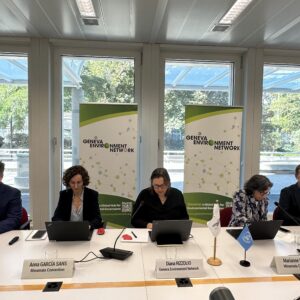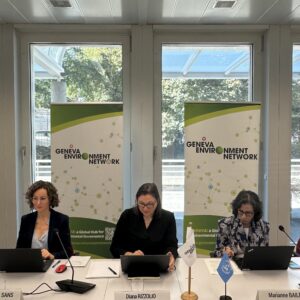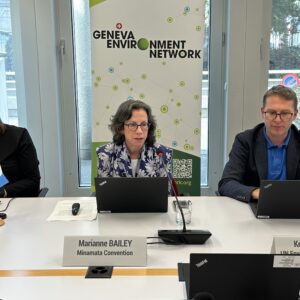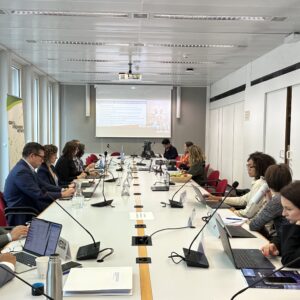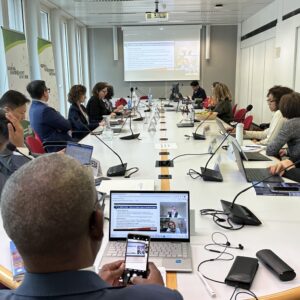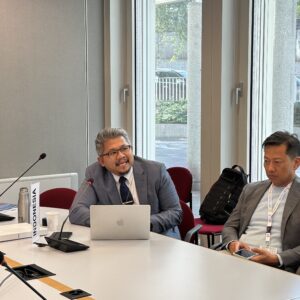Event Conference
Briefing on the 5th Meeting of the Conference of the Parties to the Minamata Convention on Mercury
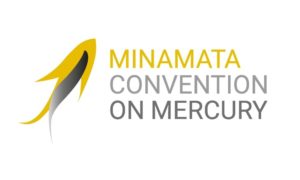
05 Oct 2023
14:00–15:30
Venue: International Environment House I, Room 2 & Online | Webex
Organization: Minamata Convention on Mercury, Geneva Environment Network
This briefing on the fifth meeting of the Conference of the Parties to the Minamata Convention on Mercury (COP-5), which will take place in Geneva, from 30 October to 3 November 2023, was organized within the framework of the Geneva Environment Network.
About this Event
The fifth meeting of the Conference of the Parties to the Minamata Convention on Mercury (COP-5) will take place in Geneva, from 30 October to 3 November 2023, under the presidency of Romania.
As part of the preparation for the meeting, online events will take place from 9 to 13 October 2023, the week marking the 10th anniversary of the adoption of the Minamata Convention, adopted on 10 October 2013 to address mercury, a heavy metal that is persistent in the environment. While naturally occurring, mercury has broad uses in everyday objects and is released to the atmosphere, soil and water from a variety of sources. Controlling the anthropogenic releases of mercury throughout its lifecycle has been a key factor in shaping the obligations under the Convention.
At this briefing, opened by the President of the Conference, the Minamata Convention secretariat provided updates on preparations for COP-5, including an overview of logistical aspects and the online events. Invited stakeholders’ provided their perspectives on the process.
Speakers

Claudia DUMITRU
President, 5th Conference of the Parties to the Minamata Convention on Mercury | Romania

Michel TSCHIRREN
Head, Global Affairs, Federal Office for the Environment, Switzerland

Marianne BAILEY
Senior Coordination Officer, Minamata Convention Secretariat
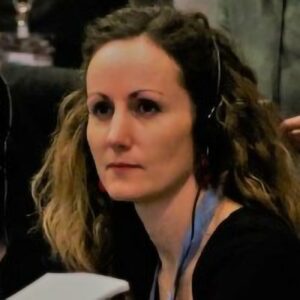
Anna GARCÍA SANS
Communications and Knowledge Management Officer, Minamata Convention Secretariat

Richard GUTIERREZ
Programme Management Officer, Minamata Convention Secretariat
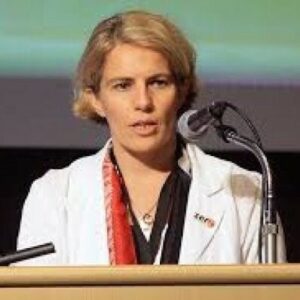
Elena LYMBERIDI-SETTIMO
Policy Manager, European Environmental Bureau | International co-coordinator, Zero Mercury Working Group

Micheal BENDER
Director, Mercury Policy Project | International Co-coordinator, Zero Mercury Working Group

Kenneth DAVIS
Program Officer, UNEP Global Mercury Partnership
Summary
Opening Remarks
Claudia DUMITRU | President, 5th Conference of the Parties to the Minamata Convention on Mercury | Romania
- The achievements of the Minamata Convention in its first ten years are well known. We have established controls on emissions and releases, as well as promoting the transformation of artisanal and small-scale gold mining. The Minamata Convention has been successfully regulating the mercury trade.
- Those actions, supported by the solid financial mechanism to implement the Convention have had visible positive impacts on developing and transition economies, as evidenced by the high rate of completion of the reporting procedures.
- The trip of the Minamata Convention is far from over and there are important duties ahead.
- We must remain committed to meeting established deadlines on a variety of fronts. We have to encourage the diligent implementation of national action plans for artisanal and small-scale gold mining while ensuring that indigenous people and local communities are fully engaged in determined approaches. We must secure the necessary funds for the Convention to be fully implemented and demonstrated to be effective in protecting people and the environment from the harmful effects of gold mining.
- It is important to acknowledge the efforts made by the African region in preparing the proposal of their amendments related to the consideration of Mercury in cosmetics, the phase-out of fluorescent lamps, and the consideration of dental amalgam. These will be an integral part of the upcoming negotiations.
- Another recent milestone is the proposal of the establishment of a mercury waste threshold, as foreseen in Article 11 of the Convention.
- The upcoming COP and the 10-year anniversary represent for all the actors involved in the process a new step forward for the youngest and very ambitious Convention.
- Global concerted efforts in the spirit of the Minamata Convention must continue, while we continue to collaborate in order to make mercury history because we can all benefit from a safer healthier future if we do work together constructively.
Michel TSCHIRREN | Head, Global Affairs, Federal Office for the Environment, Switzerland
- Minamata COP-5 marks the 10-years milestone since the adoption of this convention in 2013 and provides an opportunity to get ready for the first effective evaluation of the Convention. It also represents an opportunity to decide on further action to increase the effectiveness and addressing the ongoing issues related to mercury.
- At the 5th International Conference on Chemicals Management (ICCM5), held in Bonn from 25 to 29 September 2023, the global community agreed on a new global framework on chemicals for a planet free of harm from chemicals and waste. The framework contains five strategic objectives and a number of targets, includes a high-level declaration and 12 resolutions.
- The framework complements other international agreements and supports their implementation, meaning that COP-5 has the opportunity to discuss how the Minamata Convention can contribute to the implementation of the new framework and of the ICCM5 resolutions, and conversily how it can benefit from it.
- The new framework is a multi-stakeholder agreement linked to SDGs and which elevates the whole chemicals and waste cluster to a new political level, allowing chemicals and waste conventions to work as a team.
- Teamwork is needed to better communicate the global challenges related to chemicals, waste and pollution, and to have decision-makers realize the importance of addressing not only climate change, biodiversity loss but also pollution issues. The cost of inaction is very high.
- Minamata COP-5 is also an opportunity to get further out of the silos and demonstrate that Mercury issues should not be looked at from an environmental perspective only, but also be linked to human health, good working conditions and more.
- The setting of Geneva will be instrumental as it hosts the secretariats of various chemicals and waste conventions and the Secretariat of the new global framework. It also hosts relevant organizations such as the WHO, ILO, WTO and others.
Update on Preparations
Logistics and Organizational Matters
Anna GARCÍA SANS | Communications and Knowledge Management Officer, Minamata Convention Secretariat
- As of today, the Minamata Convention put to the disposal of participants 35 working documents available in the six UN languages and 34 information documents to facilitate information.
- Document 1, contains the provisional agenda and document 5.1 provides an overview of the agenda items to be considered during the meeting with a reference guide to the document that has been prepared by the Secretariat. Annex 2 of the annotated agenda also provides the tentative schedule of work for COP-5,
- Information document 1 (UNEP/MC/COP.5/INF/1) serves as a reference to guide the documents that have been prepared per agenda item and information document 2 (UNEP/MC/COP.5/INF/2) provides an overview of all the information related to notifications and other pertinent information.

- Registration will open on-site (CICG) from 10:00 to 17:00 Geneva Time and then will be available throughout the week from 08:00 to 17:00.
- Room assignment will be provided on site.
Richard GUTIERREZ | Programme Management Officer, Minamata Convention Secretariat
Preparations Until COP-5

- Ahead COP-5, the Minamata Secretariat has held document briefings and information sessions on National Reporting Financial Mechanism and effectiveness evaluation, which recording and documents are available on the website.
- Among the various regional meetings that took place, the indigenous people’s dialogue that took in Brasilia on 4 October was particularly relevant in supporting coordination among Indigenous organizations, particularly in matters related to the use of mercury in artisanal and small-scale gold mining, and facilitating sharing of experiences for strengthening engagement of Indigenous Peoples in the implementation of the Convention.
- On 12 and 16 October, online briefings for new parties will take place.
- Regional Preparatory Meetings
- Asia-Pacific | 5-6 September 2023 | Bangkok, Thailand
- Africa | 12-13 September 2023 | Nairobi, Kenya
- Eastern and European States | 18-19 September 2023 | Yerevan, Armenia
- Latin America and the Caribbean (GRULAC) | 5-6 October 2023 | Brasilia, Brazil
- Registration takes place in a two-step process. National focal points have been given access to the chrono online registration system and they are to input the needed information. The second step is the sending of the nomination letters to the Executive Secretary. Consulting the Information for Participants tab on the official website is advised.
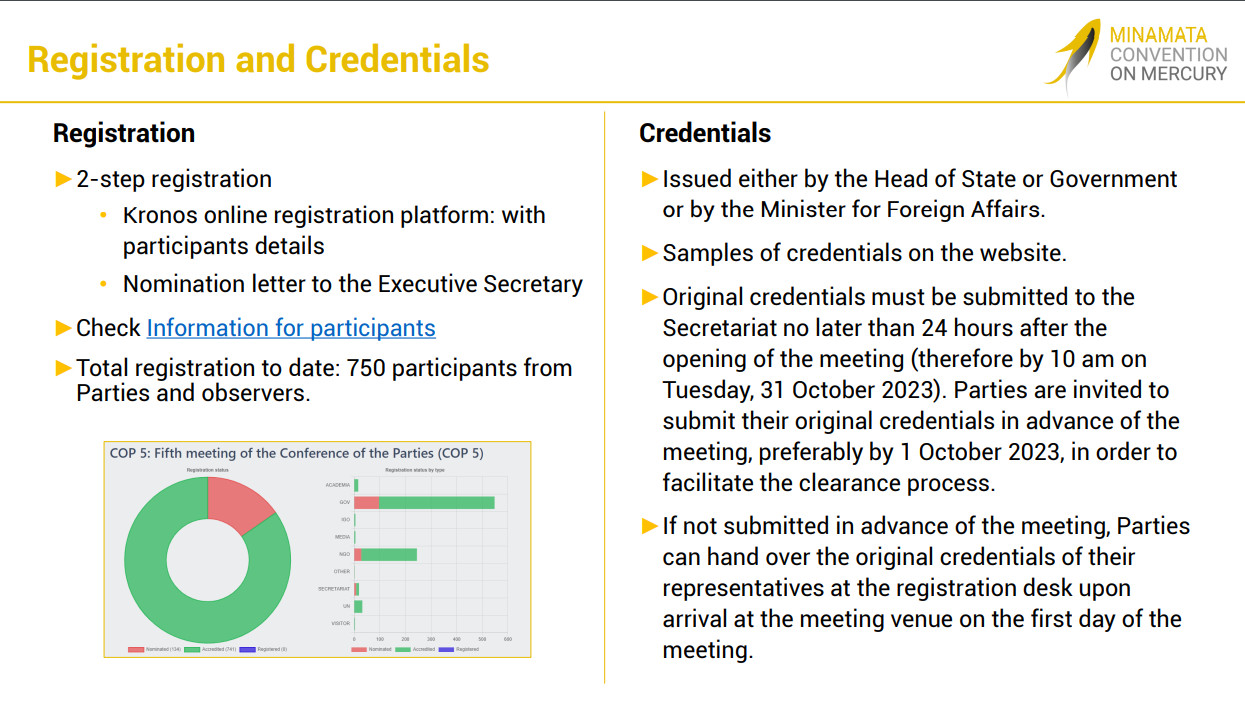
Relevant policies for observation

Anna GARCÍA SANS
- Besides the Minamata Convention website – offered in English, French and Spanish with all documents in all six UN languages – to support participants during the event with the most updated information, there is the possibility to use the Intranet of the website to access contact groups documents and statements.
- The Online Budget Forum will be available until 13 October 2023 for participants to submit comments.
- For COP-5, the streaming of Plenary Sessions will be guaranteed.

Substantive Matters
Marianne BAILEY | Senior Coordination Officer, Minamata Convention Secretariat
- A key item for COP-5 will be the continued work on mercury-added products and industrial processes using mercury. At COP-4 there were eight product categories added for phase-out by 2025 and two new requirements on dental amalgam: these entered into force just last week for those parties that have opted to not separately ratify those amendments.
- COP-5 will continue its work to consider:
- phase-out dates for four other mercury-added products that were deliberated on at COP-4 for which only the phase-out date is to be decided by COP-5,
- whether to shift polyurethane production using mercury-containing catalysts to a specific phase-out date
- the availability of non-mercury alternatives for two industrial processes already controlled but not phased out in the annexes.
- During the intersessional period, extensive work, submissions and technical information on the availability of alternatives were conducted.
- The COP will consider three sets of amendment proposals. These were submitted by Botswana and Burkina Faso on behalf of the Africa region, and they cover additional categories of fluorescent lamps, mercury content of skin-lightening products, and additional, dental amalgam requirements.

Emissions, Releases and Waste
- Emissions are a notable agenda item because mercury emissions are the major pathway for global environmental impact. This agenda item has not been on the COP agenda since the adoption of the important guidelines for implementation at COP-1.
- National reporting demonstrates that many of our parties are taking the required measures in advance of deadlines, but with key deadlines really looming on emissions control, parties have a great deal of implementation to undertake.
- COP-5 will address releases of mercury to land and water, considering the draft guidance on BAT/BEP for those releases. articulated in the convention. The draft guidance was prepared by a group of technical experts that was chaired by Chile and Eswatini.
- Waste will be one of the more challenging issues, liley to go to a contact group to continue and hopefully conclude considerations of threshold values that would apply to waste contaminated by mercury above which the general requirements of the waste article would apply and which already applied to waste consisting of mercury and waste containing Mercury. A group of technical experts has conducted a great deal of work on this, issuing recommendations as well as some choices for the COP to make on the numerical value.
Further information is available on slide 33 of the presentation, available under the document section of this page.
Review of the Financial Mechanism
- This will be the second review of the financial mechanism. The COP will also address the GEF Council report to COP, in the context of GEF-8 considerable increase of fund allocation – USD 269 dollars / 30% increase; and in the context of the specific international program which is the second part of our financial mechanism and is in its midterm evaluation. Further information is available on the fourth round of applications to the SIP, which our governing board has not been able to launch yet because the contributions have not yet been sufficient for that purpose.
- The review of the financial mechanism will discuss the level of funding; the integration across focal areas within the GEF; the ability of parties at the national level to work together through their GEF operational focal points to make that kind of integration an increase in results of the GEF projects for mercury. These actions are aimed at scaling up and providing advantages in the implementation of biodiversity, climate change and other topics but also for those benefits to flow back to the Minamata convention in terms of full implementation.
Artisanal and Small-scale Gold Mining
- ASGM remains the largest source of mercury use, and emissions globally.
- To give the parties solid information on where we are in implementation, through notifications submissions of the review of national action plans and the providing information on where we are at in trying to have all the parties that notify on GEF have their national action plans in place and being implemented.
- The other important part of the ASGM decision will be the follow-up of COP-4, having the voices of indigenous peoples and local communities more prevalent in the design and implementation of national action plans.
- Plenty of work has been devoted to this case, as symbolized by the indigenous people’s dialogue that took in Brasilia on 4 October, an important and well-attended meeting.
- The Minamata Convention launched the Indigenous People’s Platform and the draft decision prepared for this topic will help move forward this work in an inclusive way and keep the parties on track for their implementation.
Biodiversity
- The recent adoption of the Kunming-Montreal Global Biodiversity Framework was a turning point for the Minamata Convention. Our parties at COP-4 requested that we identify a set of activities that could be undertaken in the upcoming biennium to advance the implementation of the Kunming-Montreal GBF by tackling mercury, a key driver of biodiversity loss.
- This relates to target seven of the GBF on highly hazardous chemicals. We discussed the possibility for the expert group on indicators under the GBF to look at mercury under Target 7 closely but there are also other targets that our work to address mercury can impact positively.
- The information document 27 (UNEP/MC/COP.5/INF/27) provides a useful analysis of how the Minamata Convention and the framework can be mutually implemented and increase mutual results.
Mercury Supply Sources and Trade
- This article has not been brought up in recent COPs despite the importance of its implementation.
- On the margins of COP-4, the host government of Indonesia brought forward the Bali Declaration on Combatting Global Illegal Trade of Mercury.
- In the context of our first full national reports bringing forward a lot of information and challenges on Article 3, we have prepared a draft decision to continue advancing work not only on the consent regime for trade in elemental mercury but also on the other aspects of article 3, which includes identifying stocks, supply and sources in the party’s territory, as well as controlling excess mercury and addressing and eliminating primary mercury mining. (Further information available in UNEP/MC/COP.5/3 – Mercury supply sources and trade)
Capacity-building, Technical Assistance and Technology Transfer
- Article 14 on this topic has a requirement for the COP to periodically consider information on alternative technologies needs and challenges of the parties in relation to technology transfer.
- The draft decision proposes some work that we would undertake to prepare for the COP consideration at some point in the future, as well as implementation and compliance committee’s recommendations on capacity building that flow from the national reporting needs expressed by parties and it also talks about the role of both the Secretariat and the UNEP Global Mercury Partnership, a key player in the whole perspective of capacity-building for parties and other stakeholders.
- The Global Mercury Partnership’s work is brought forward to some degree in our meeting document and they have also provided their full report in an information document.
- Another information document relevant to this topic is the GEF-funded Planet Gold program, which provided a key information document on the transfer experiences from the first eight countries participating in their program on ASGM.
National Reporting
- We undertook a tremendous effort not only to make sure our parties knew how to report and could do it easily but also to ensure their reports were complete. We are very proud our reporting rate is at 95% for the first full national reports.
- Various factors played into this success – like our online reporting tool – on top of the tremendous efforts of many players.
- The Secretariat compiled loads of Information on the national reports for consideration by the Implementation and Compliance Committee (ICC), which spent the past biennium the course of two meetings looking at the information coming out of the national reports. (Further information can be found in UNEP/MC/COP.5/INF/20)
- For this agenda item, the ICC recommendations on potentially amending the reporting format or tweaking the reporting guidance will come forth. Other ICC recommendations are highlighted in the meeting documents for other agenda items.
- National reports are submitted by national focal points and we have an excellent gender balance among our national focal points.
Effectiveness Evaluation
- The work has been initiated at COP-4. It started the first effectiveness evaluation, adopted the framework, and established the open-ended scientific group, which met various times, including an in-person meeting in Geneva.
- COP-5 must establish the effectiveness evaluation group. Within that, COP-4 already established the terms of reference for the effectiveness valuation group, leaving the decision on its membership out.
- COP5 will also address indicators that have been worked on by parties over the last two or more years. Those are there for their consideration and hopefully adoption, then also the end date of the first effectiveness evaluation.
Gender
- The MC Gender Action Plan to be advanced at the COP provides a blueprint for actions to promote gender equality actions that the Secretariat, the parties and stakeholders could undertake.
- We already incorporate gender considerations into all the work of the financial mechanism and in many other aspects of the Convention and COP implementation: we think the gender action plan will just take it that much more forward and really be a leading voice on this topic in line with what other MEAs do.
Knowledge Management
- Knowledge Management is a new COP agenda item.
- A digital strategy will guide the Secretariat’s work better to support parties in the implementation of the convention with a digital ecosystem, building partnerships governance and Innovation in the implementation of our knowledge management work with key stakeholders like InforMEA.
- We are really quite proud of the work that we have already done within the digital ecosystem, such as the reporting dashboard and a projects database and dashboard for both our GEF projects, just the Mercury allocation as well as it will start our specific international program.
COP-5 Events
Richard GUTIERREZ
- Minamata COP-5 events are an informal platform for parties and observers to share information and bring knowledge to advance technology, research, and policy at the COP-5.
- These events aim to stimulate information exchange and build effective participation of stakeholders in the process of COP-5 in its decision-making process.
- Three types of COP-5 events will be happening:
- Online events. Twenty-one online events have been organized, six of which by parties and 15 by stakeholders which come from Academia, private sector, IGOs and NGOs and cover a whole wide range of topics
- Knowledge lab sessions are designed to be simple and straightforward, allowing access and ease engagement. These will take place at CICG during lunchtime and currently, 13 knowledge labs are currently scheduled with three organized by parties and 10 events by stakeholders ranging from Academia, IGOs, and NGOs and indigenous people’s organizations.
- Special events or Exhibitions. The exhibition focuses on technologies and policy development happening in the field. A range of 16 exhibitors will be on the ground floor of CICG. The United Nations Environment Programme (UNEP) will host the event “Mercury in Cosmetics: more than what meets the eye”. The aim is to confront the narrative questioning, the promotion and the normalization of skin lightening.
Anna GARCÍA SANS
- Next week will mark the 10th anniversary since the Minamata Convention was signed in Kumamoto. Despite the may achievements in this decade, there is still much to be done to address mercury pollution.
- In this context, the Secretariat has been organizing several activities:
- A video documentary that includes many voices to bring justice to our history.
- A web story with UNEP colleagues will be released on 6 October, bringing back memories from the very beginning.
- A Film projection of the Minamata movie on Sunday 29 October at 18:15 at CICG will also feature a debate with the director Andrew Levitas and representatives of the Minamata Convention Promotion Network and the Executive Secretary.
- A special event “Minamata Convention, a decade of global commitment to make mercury history” will take place on 30 October from 13:15 to 14:45. This event will share views of relevant stakeholders who will provide insights into the Convention’s progress over 10 years, aiming to bring both remembrances and focus on the human aspect. It will feature diverse voices, including representatives from parties, NGOs, financial mechanisms, indigenous peoples, and artists engaged in environmental causes, inviting them to reflect on what the convention means to each of them.
- During the whole COP-5 week, participants can visit the #MakeMercuryHistory Photo Exhibition at CICG, part of the photo contest” the Secretariat organized and the winners were announced during World Environment Day. For those who cannot attend in person, the exhibition is also accessible from the website in a virtual manner.
Anna Garcia Sans:
- Next week is marking a decade since the convention was signed in Kumamoto, and despite all the progress that is still much to be done to address Mercury pollution.
- The Minamata Convention is a young and an ambitious convention: in this context the Secretariat has been organizing several activities.
- We are producing a video documentary that includes many voices to bring Justice to our history.
- We are also producing a web story with UNEP colleagues that will be released tomorrow also bringing many memories from the very beginning when the the convention was divided um for the before the cop um on Sunday 29 October at 7 p.m.
- There will be a movie projection of the Minamata movie that was produced by Andrew Levitas: we will count with the presence of him and also with representatives of the Minamata Convention on promotion Network and the executive secretary. This event is co-organized thanks to Geneva Environment Network, it will be free and you will have more information on the upcoming days and looking forward to see the room full of people.
- Watching the movie and another activity organized with the Geneva Environment Network is a special event on during COP-5 which is called: “Minamata Convention, a decade of global commitment to make mercury history” and it will happen at lunchtime at CICG.
- This event will share the views of relevant stakeholders who will provide insights into the convention progress over 10 years aiming to bring both remembrance and hope with a focus on the human aspect, it will feature diverse voices some of them here we will hear from them later on but including representatives from parties NGOs, financial mechanism, indigenous peoples and artists engaged in environmental causes, inviting them to reflect on what the convention means to each of them and finally during the whole COP-5 week participants can visit the make mercury history photo Exhibition at CICG this exhibition is part of the “Make Mercury history photo contest” that the Secretariat organized and the winners were announced during the world environment day. For those that cannot attend in person the exhibition is also accessible from our website in a virtual manner.
Michael BENDER:
- The Zero Mercury Working Group is an international coalition of around 110 public interest environmental and health NGOs from over 55 countries with our aim to reduce and eliminate mercury supply, use emissions exposure, and support the implementation of the Minamata Convention. The Zero Mercury Working Group has created views for those of you who have been around for a while before each major Global Mercury meeting.
- The ZMWG has been developing its views on Mercury-Added Skin-Lightening products, where it has observed a strong emphasis on marketing of these products to women of color, being a clear case of colorism that goes back Centuries. It also raises social and environmental injustice concerns, underlining the level of poverty driving the use of these toxic skin-lightening creams by many women around the globe, girls and men.
- We are supporting the African Amendment of the Convention, which focuses on the ban on mercury-added cosmetics. As stated in Art. 4 of the Convention, cosmetics containing over one part per million are to be ended by the end of 2020 with some exceptions for eye shadow.
- The African regional proposal is a ban on mercury-added cosmetics and we would be proposing to support them by deleting the threshold of one part per million. There are many developing countries and civil society where we have been conducting market surveillance and trying to assist governments around the world, and clearly, the most cost-effective and quickest approach is through the use of handheld testing devices like XRF, which use can be taught to costume services health ministers, environmental ministers.
- This amendment would also shift the burden onto manufacturers to prove that they are not adding mercury to each other products.
- Similarly to what is contained in Annex A part 2 on dental amalgam, there would be a setting of national objectives to stop the sales of marketing. The Convention often looks mostly at the manufacturer and trade side but lots of studies, and testimonials show that these advertisements are very focused on women and children and particularly. In certain countries there is a tremendous Focus on television commercials.
- Another tool is publicizing advisories licensing agreements engaging online platforms. It is a very challenging area that countries have been starting to address through volunteer initiatives. Again, fostering the inter-agency and Regional Global collaboration and coordination hopefully with the Minamata Convention helping to lead the charge.
- There is a need to control mercury compounds which facilitates the production of mercury skin-lightning creams and the first step. We need to see an assessment of the global supply and trade of mercury compounds.
- For many developing countries, alternatives to mercury-added lamps and dental amalgam are cost-prohibitive.
- At COP-4 we make great strides and teed up for the important work ahead which we believe should culminate in a ban on manufacture and trade by 2025. Similarly, with dental amalgam, we believe the manufacturer and trade band is feasible by 2030 without undermining dental care and one only needs to look at the list of a growing list of countries that are phased down and phased out of amalgam.
- There is a growing need for specifically targeting mercury-added products under Article 4 and better-prioritizing waste collections. We constantly are getting questions from developing countries as there is little clarity around that.
- It is vital to underline the importance for national governments to get the support that they need to implement the Convention.

Kenneth DAVIS | Program Officer, UNEP Global Mercury Partnership
- The UNEP Global Mercury Partnership has been active since 2005 and provides a critical role in fighting mercury pollution.
- As a multi-state stakeholder multi-sectoral voluntary partnership, the Global Mercury Partnership comprises over 250 Partners from governments, intergovernmental organizations, civil society,NGOs, industry, the private sector and the research community.
- These partners share a common goal of taking immediate action to reduce mercury pollution.
- Starting before the existnce of the Minamata Convention, the partnership did important work in catalyzing public opinion and setting the groundwork for the Minamata Conention on Mercury.
- The partnership supports the implementation of the Convention by providing knowledge resources, scientific expertise on mercury, awareness raising and technical and capacity-building expertise to specific areas.
- The Partnership is structured around eight areas.
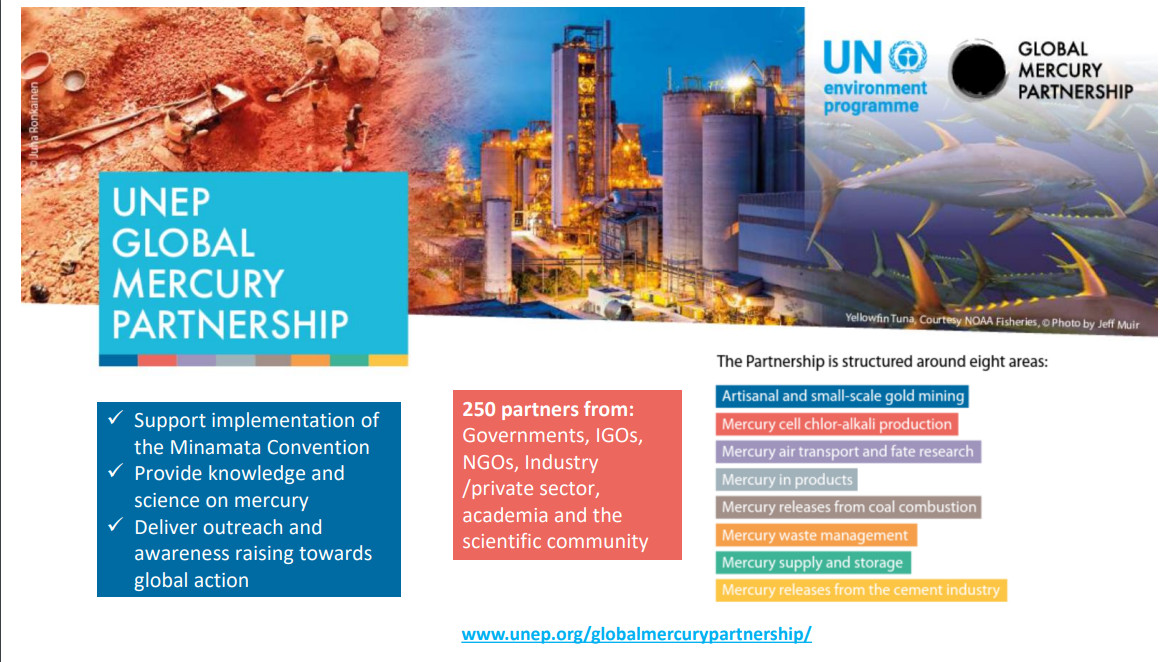
- In the lead-up to COP-5, the partnership conducted various ctivities available in COP-5 INF/32.
- The governing mechanism of the partnership – the Advisory Group – met last year in November on the margins of the OECD Global Forum on the Environment, facing discussions on mercury in oil and gas and mercury in non-ferrous metals smelting and mining.
- While exploring how to disseminate this work area where we have few partners, discussions also tackled mercury trade, flows, supply, and stocks. Many of the members of the partnership Advisory Group expressed the wish to work in a crosscutting manner on this issue of mercury trade, including trade in compounds that are used in skin-lightening products and in trade in products.
- The need for better support on mercury-added product, disposal, and disposal of the waste is a perennial need discussed by our partners.
- Another topic addressed is the need to establish better linkages with the biodiversity and climate change clusters, linking the convention with the Kunming-Montreal Global Biodiversity Framework.
- The partnership conducts also in-depth work supporting projects on mercury and skin-lightening products, and mercury in dental amalgam.
- Artisanal and small scale gold mining, a specific area of our work and a key agenda item of COP-5. It represents the main obligation of parties with ASGM the national action plans have been steady.
- Parties have been increasingly completing and submitting national action plans to the Secretariat, and the partnership has been active over the past months in analyzing the data from NAPs.
- We have created a data framework, and we have been pulling out key information from these national action plans. Two data dashboards can be explored and what these have revealed to be a great support for discussions on ASGM at COP-5. We are seeing some very ambitious phase-out targets and implementation plans.
- Data quality in terms of mercury use and on the number of miners has improved, but we have also seen a lot of gaps in understanding this informal sector.
- The maps are interactive and can be used to offer insights.
- Information document 6 (UNEP/MC/COP.5/INF/6), developed in collaboration with the Secretariat of the Minamata Convention contains a more in-depth analysis of this data.
Q&A
Q: With regards to the proposed Amendments by the Africa Group, will there be specific contact groups or any session arranged to clarify these proposals?
Marianne BAILEY:
- We do expect there will be a contact group on the annexes and amendments that were proposed.
- This was explained in further detail during regional meetings. As part of the preparatory briefings, we dedicated two sessions to documents. (Breifing 1 & 2| 30 -31 August 2023)
- Minamata online events also delved on artisanal and small scale gold mining, on reporting on effectiveness evaluation and financial resources and mechanisms.
- We expect also that the waste threshold issue and the program of work and budget topic will have a contact groups formed.
- Since our parties insist that we only have one contact group meeting concurrently with the plenary or two contact groups meeting at any given time when plenary is in session, we have tried to design it such that just those three contact groups would be needed, but additional contact groups could be created.
Richard GUTIERREZ
The Sunday Briefing on 29 October 2023 taking place from 12:30 to 13:00 will cover national reporting and on the implementation and compliance committee.
Highlights
Minamata COP-5 Online Events
As part of the preparations for the meeting, Minamata COP-5 Online Events will take place during the week of 9 to 13 October 2023, the week marking the 10th anniversary of the adoption of the Minamata Convention. The Geneva Environment Network will co-host three sessions:
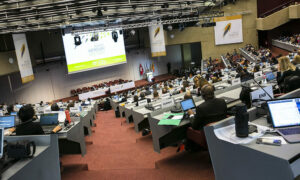

Catalyzing Project Impact and Visibility Through Knowledge-Driven Capacity-Building | Minamata COP-5 Online Event
10 October 2023 | 14:45 – 15:45 CEST

Advancing a Rights-based Approach to Addressing Mercury Contamination | Minamata COP-5 Online Event
11 October 2023 | 16:30 – 17:30 CEST
Video
Live on Webex
Live in the Room
Photo Gallery
Documents
Links
- Fifth Meeting of the Conferences of the Parties to the Minamata Convention
- Towards the Fifth Meeting of the Conference of the Parties to the Minamata Convention on Mercury (COP-5)
- Geneva addressing Hazardous Substances
- Eliminating Mercury Skin Lightening Products | UNEP Global Mercury Partnership
- Phasing-down the Use of Dental Amalgam | UNEP Global Mercury Partnership
- Insights from ASGM National Action Plans | UNEP Global Mercury Partnership

